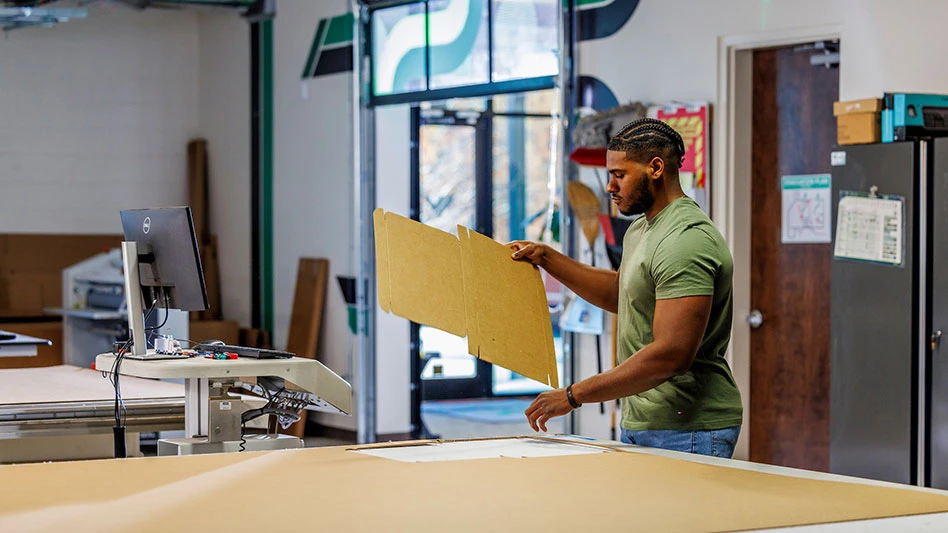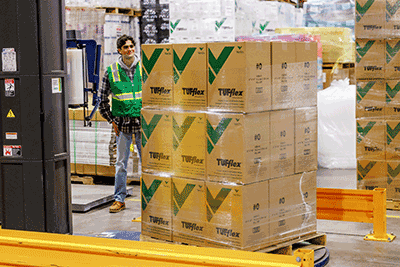
Photo courtesy of Vertiv Corp.
The market for sustainable packaging is growing in response to a number of factors that range from consumer demand to legislation.
According to Arizton Advisory & Intelligence, a market research firm based in Chicago, the global sustainable packaging market is expected to reach $491.75 billion by 2029 from $319.62 billion in 2023, for a compound annual growth rate of 7.44 percent.

As senior director of sustainability at Veritiv Corp., a business-to-business packaging, print and facility solutions provider based in Atlanta, sustainable packaging is an issue Martha Issa is passionate about. She applies her engineering and marketing background to strategize, design and implement Veritiv’s sustainable product footprint. In her 15-plus years with Veritiv, she has served in management roles within Veritiv’s Facility Solutions and Marketing teams.
In the interview that follows, she shares her perspective on sustainability and emerging trends in sustainable packaging.
Q: What does sustainability mean for businesses like yours?
Martha Issa (MI): I see sustainability as both a responsibility and an opportunity in packaging.
Sustainability drives growth, profitability and long-term value while at the same time safeguarding natural systems for generations to come. We feel morally and ethically obligated to reduce our environmental footprint. We also want to keep our communities safe and healthy. I think corporations play a crucial role in charting the course for the future and have the ability to impact change.
There is also an expectation from our customers (and ultimately end users who open packages) to provide smart designs with sustainable materials. Packaging is the first opportunity to show how important sustainability is to a brand, and users want to see materials that are recycled or recyclable. They want to see that you care about the environment as much as you care for them. Designers work with our global suppliers to find new materials as we strive to constantly offer inventive, sustainable alternatives.
Q: Speaking of sustainable alternatives – what trends are you seeing?
MI: Each company has its own sustainability goals—recyclability, emissions and/or reducing materials. Companies are increasingly prioritizing their focus on reducing the cost of packaging while at the same time looking for sustainable alternatives. Decreasing the use of single-use plastics in packaging is a huge trend. Customers want fiber-based solutions that can be easily recycled at home or in facilities or biodegradable alternatives to traditional single-use plastic packaging.
In addition, companies are anticipating upcoming regulations that will require a minimum percentage of recycled content in all single-use plastics, so they are adding recycled content to their packaging materials.
We are also seeing customers who want to use less material, which reduces the item’s weight and lowers transportation and supply chain impacts. This helps to minimize carbon emissions with efficient logistics.
For some time now, companies have been right gauging their stretch film, which means they are analyzing the correct thickness and amount of film to ensure palettes are not overwrapped. The new trend is sustainable machine stretch film. Veritiv’s TUFflex line of machine stretch film includes up to 30 percent postconsumer resin (PCR). We offer a Secure Wrap Analysis, which can help to identify inefficiencies and recommend the right stretch film for each use, which saves time and financial resources.
Each alternative comes with its own challenges and opportunities when it comes to reducing environmental footprints, so it’s important to weigh all sustainable options and find the best fit for each company’s unique goals.

Q: How do you work with your customers to weigh sustainable options for packaging solutions?
MI: There is no one-size-fits-all approach to sustainability. We consider all aspects of the supply chain from design through delivery to innovate sustainable packaging products for our customers.
It is important to remember that first and foremost packaging material must serve its purpose to safely transport the product. That could mean that plastic is recommended and necessary. For example, in the food and health care industries, single-use plastics must be used to meet current safety and hygiene requirements. In those cases, we work with customers and suppliers to reduce the amount of plastic in the packaging and offer recyclable products while continuously searching for plastic alternatives.
We use a life cycle analysis (LCA) to evaluate environmental impacts of packaging, taking into account the whole product life from start to finish—from manufacturing to distribution to end-of-life impacts. This information is crucial to our decision-making process. LCAs can provide additional environmental impact information, such as water consumption, carbon emissions and human impact. Different companies might care more about one aspect over the other, and an LCA can help prioritize reducing the impact that is most important for that specific customer. We also ask our customers about their goals and together weigh what is the best option.
Q: What are some ways companies are reducing the use of single-use plastics?
MI: We see customers reducing the impact of single-use plastics in several ways, including:
- reducing the amount of resin utilized in current products;
- increasing the number of products containing postconsumer and postindustrial recycled resin;
- offering alternative substrates that can either be easier to recycle, compost and/or assimilate by the environment; [and]
- recycling stretch film to extend its lifetime beyond single use to reuse.
When reducing single-use plastics isn’t a viable option, we help our customers recycle materials that are hard to recycle, such as stretch wrap, bubble warp, strapping, etc.
Q: What other trends do you see on the horizon for packaging?
MI: There are several impending regulations that are intended to reduce environmental impacts of packaging, addressing mainly single-use plastics. For example, extended producer responsibility (EPR) regulations are designed to make companies responsible for the end of life of the packaging they utilize. There are local and state regulations banning specific products, such as plastic bags or Styrofoam. Some U.S.-based companies are also required to comply with EPR regulations in the European Union (EU) if they are exporting products to other EU countries.
Since these regulations are being passed at various levels of government, and different regulations have different timelines for implementation, it will be crucial for companies to work with partners like Veritiv to navigate the new landscape and comply with regulations.
Latest from Recycling Today
- Orion ramping up Rocky Mountain Steel rail line
- Proposed bill would provide ‘regulatory clarity’ for chemical recycling
- Alberta Ag-Plastic pilot program continues, expands with renewed funding
- ReMA urges open intra-North American scrap trade
- Axium awarded by regional organization
- Update: China to introduce steel export quotas
- Thyssenkrupp idles capacity in Europe
- Phoenix Technologies closes Ohio rPET facility





